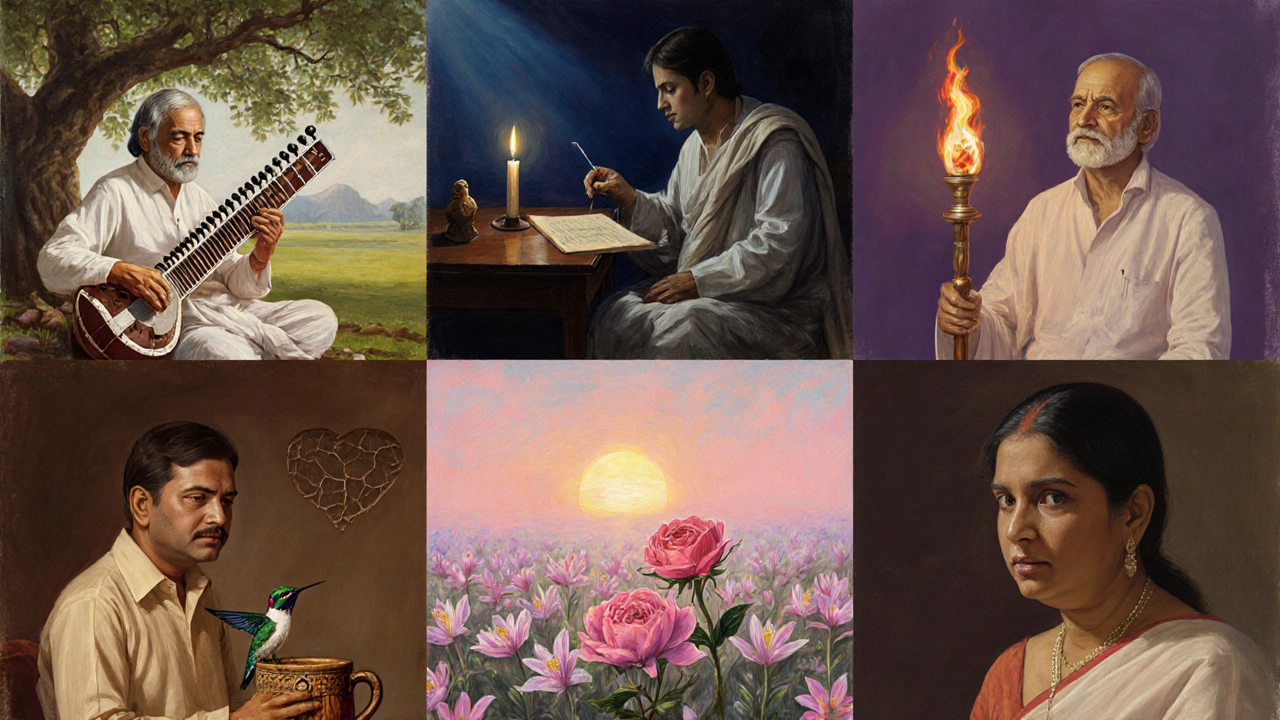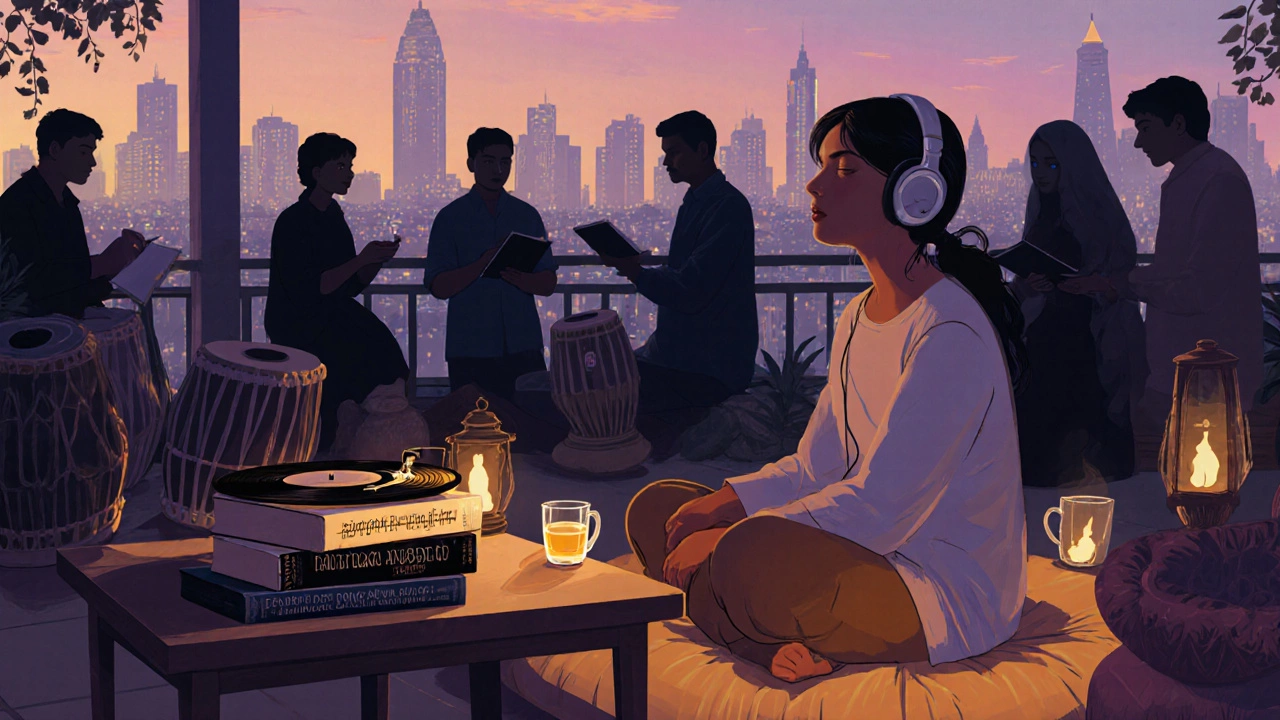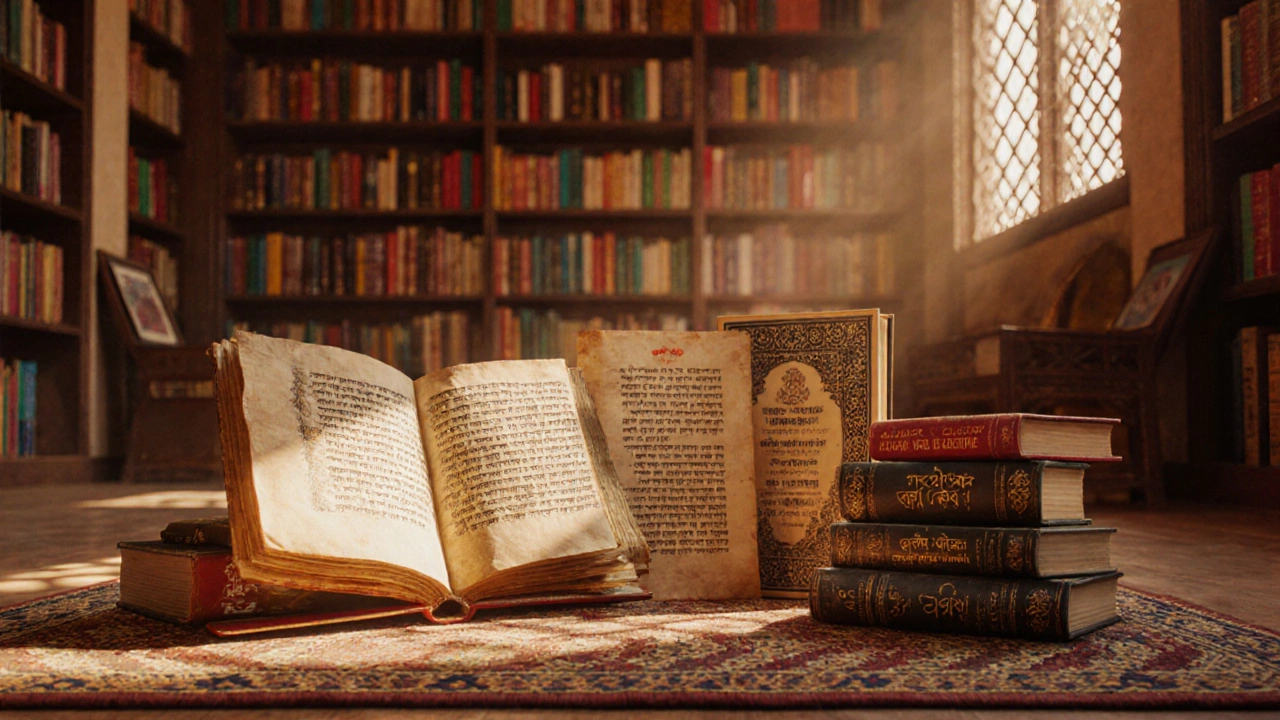When we talk about Indian poetry is a vibrant literary tradition that stretches from Vedic hymns to contemporary verses, mixing many languages and cultural flavors, a common question is: who actually penned the most beautiful poems? The answer isn’t a single name but a handful of voices that have shaped how generations feel love, spirituality, and nature.
Key Takeaways
- Beauty in poetry is judged by emotional depth, lyrical flow, and lasting impact.
- Rabindranath Tagore, Mirza Ghalib, Kabir, Sarojini Naidu, Amrita Pritam, Harivansh Rai Bachchan, Subramania Bharati, and others are repeatedly cited for their exquisite verses.
- Each poet brings a unique regional language and theme, making Indian poetry a mosaic of beauty.
- Reading a short excerpt of their hallmark poems gives a quick feel of why they’re celebrated.
- To explore more, follow curated anthologies, online archives, and local literary societies.
What Makes a Poem “Beautiful”?
Beauty isn’t a fixed formula; it’s a combination of several elements that together stir the heart. Scholars often point to three pillars:
- Emotional resonance - the ability to evoke deep feeling, whether joy, sorrow, or wonder.
- Musicality - rhythm, meter, and sound patterns that make the words sing.
- Universal relevance - themes that stay fresh across centuries and cultures.
When a poem checks all three boxes, readers across India and the world tend to label it beautiful.
Top Indian Poets Known for Their Beautiful Poems
Below are the eight poets whose work most often appears on lists of the most lyrical and moving Indian verses.
Rabindranath Tagore is the Nobel‑winning Bengali poet whose songs (Rabindra Sangeet) and short verses blend mysticism with everyday love. His poem “Ekla Chalo Re” is celebrated for its simple yet powerful call to self‑reliance.
Mirza Ghalib is an Urdu‑Hindi poet of the 19th century, famed for couplets that weave satire, melancholy, and philosophical depth. Ghalib’s ghazals like “Dil-e‑nadaan” linger in the Persian‑influenced tradition of love‑loss.
Kabir is a 15th‑century mystic bard whose dohas (two‑line verses) cut through ritual and speak directly to the soul. His poem “Moko Kahan Dhunde” remains a staple in school curricula for its crisp clarity.
Sarojini Naidu is the “Nightingale of India,” whose English verses blend patriotism with sensual images of nature. “The Gift of India” showcases lyrical patriotism while “The Humming‑Bird” delights with delicate imagery.
Amrita Pritam is a Punjabi‑language poet whose post‑partition poems merge heartbreak with fierce feminine voice. Her line “Ajj Aakhaan Waris Shah Nu” is quoted in every talk on love‑loss.
Harivansh Rai Bachchan is a Hindi poet best known for “Madhushala,” a wine‑house allegory that explores existential yearning. The refrain “Madhushala” itself has become a cultural chant.
Subramania Bharati is a Tamil revolutionary poet whose verses fuse freedom, women’s emancipation, and vivid natural imagery. His poem “Poonkodi” exemplifies lyrical devotion to the motherland.
Mahadevi Varma is a Hindi poet of the Chhayavaad movement, celebrated for introspective and sensuous verses that explore inner consciousness. “Ye Gudiya” remains a touchstone for modern Hindi poetry.

Comparison Table - Who Writes the Most Beautiful Poems?
| Poet | Era | Primary Language | Signature Beautiful Poem | Dominant Theme |
|---|---|---|---|---|
| Rabindranath Tagore | 1861‑1941 | Bengali | Ekla Chalo Re | Self‑reliance & Spiritual Unity |
| Mirza Ghalib | 1797‑1869 | Urdu/Hindi | Dil‑e‑Nadaan | Love & Existential Sorrow |
| Kabir | 15thcentury | Hindi (with Persian influence) | Moko Kahan Dhunde | Spiritual Simplicity |
| Sarojini Naidu | 1879‑1949 | English | The Gift of India | Patriotism & Nature |
| Amrita Pritam | 1919‑2005 | Punjabi | Ajj Aakhaan Waris Shah Nu | Heartbreak & Partition |
| Harivansh Rai Bachchan | 1907‑2003 | Hindi | Madhushala | Existential Longing |
| Subramania Bharati | 1882‑1921 | Tamil | Poonkodi | Freedom & Nature |
| Mahadevi Varma | 1907‑1987 | Hindi | Ye Gudiya | Introspection & Sensuality |
Sample Excerpts - Feel the Beauty Yourself
Rabindranath Tagore - “Ekla Chalo Re” (Excerpt)
"যদি তুমি একলা চলো,
যদি তুমি একলা চলো,
যদি তুমি একলা চলো, তবে সবার দোয়ায়া তোমার সঙ্গে হবে।" (Translation: If you walk alone, the whole world’s prayers walk with you.)
Mirza Ghalib - “Dil‑e‑Nadaan” (Excerpt)
"दिल‑ए‑नादाँ तमाशा है, हीरोशे भर के ख़ुदी को समझ लो, कला‑ई‑मालिक की सच्ची मायाचारा की चाह रे।" (Translation: Oh naïve heart, see the drama; understand the divine art, desire the true love of the creator.)
Kabir - “Moko Kahan Dhunde” (Excerpt)
"मोको कहाँ ढूँढे फ़िरूँ दोना रुसा आदि,
जिन मकबरे में तील् न जाँब, गुहें बांझ चाहत निए।" (Translation: Where do you seek me? In tombs or shrines? I am beyond forms, beyond empty desire.)
Sarojini Naidu - “The Gift of India” (Excerpt)
"The restless world has weary hearts
And the desolate plains sing of a gift.
From Asia’s mystic dawn we bring our golden light,
India’s gifts are boundless, tender, bright."
Amrita Pritam - “Ajj Aakhaan Waris Shah Nu” (Excerpt)
"ਅੱਜ ਜਾਂਦਾ ਸੀ ਵਾਰਿਸ ਝੀ ਨਾਲ…
ਜੋੜੀ ਲੀ ਓਹੀ ਆਂ ਦਿਲ ਨੂੰ ਏਦਾ…
ਸਿਰ ਲੇ ਦੇ ਪਰੇ ਪਿਆਰ ਨੂੰ…" (Translation: Today I call Waris Shah - your tears are the rivers of Punjab’s broken heart.)
Harivansh Rai Bachchan - “Madhushala” (Excerpt)
"Madhushala, Madhushala, …
Jab tak ye raunak hai, badge ek dhuaa‑
…" (Translation: The tavern lives as long as there’s light, even a puff of smoke becomes a hymn.)
Subramania Bharati - “Poonkodi” (Excerpt)
"பூங்கொடி புல் நிலம்பில்…
நித்தியமா ஒளியிடன்,..
…நீ தான் என என் காதல் கடலின் ரஷ்மி." (Translation: In the field of blooming flowers, an eternal light shines- you are my love’s endless wave.)
Mahadevi Varma - “Ye Gudiya” (Excerpt)
"ये गुड़िया, मेरे सामने बसी है,
रहस्य के पन्ने जैसे…
क्या कहना, कैसा हलचल अर्थ…"
(Translation: This doll sits before me, a page of mystery, how can I describe the trembling meaning?)

How to Dive Deeper into India’s Most Beautiful Poetry
- Read anthologies: Look for collections like “The Penguin Book of Indian Poetry” or “Modern Hindi Poetry: An Anthology.”
- Explore online archives: Digital libraries such as the Digital South Asia Library or the Poetry Archive of India host full texts.
- Join local literary circles: Cities like Kolkata, Lucknow, and Chennai hold monthly poetry meetings where members recite classics.
- Listen to musical adaptations: Many of Tagore’s Rabindra Sangeet or Ghalib’s ghazals are set to music-listening helps you feel the rhythm.
- Take a language‑learning approach: Even a basic grasp of Bengali, Urdu, or Tamil unlocks nuances lost in translation.
Frequently Asked Questions
Which Indian poet is most often called the “poet of love”?
Mirza Ghalib’s Urdu ghazals are usually cited as the epitome of love poetry, especially for their blend of passion and melancholy.
Are there modern Indian poets whose work rivals the classic beauties?
Yes. Poets like A.K. Ramanujan (English) and Jeet Thayil (English) write contemporary verses that echo the lyrical depth of older masters while addressing today’s urban themes.
Where can I find free PDFs of the highlighted poems?
The National Digital Library of India and the Internet Archive host public‑domain works of Tagore, Kabir, and Bharati. For more recent poets, their families often release PDFs on personal websites.
Do any of these poets write in English?
Sarojini Naidu and Mahadevi Varma composed primarily in English, while many others have been translated by reputable scholars, preserving lyrical quality.
How can I start writing beautiful poems inspired by these masters?
Begin by memorizing a short excerpt, then rewrite it in your own voice. Focus on one of the three beauty pillars-emotion, rhythm, or universal theme-each time you draft a line.
